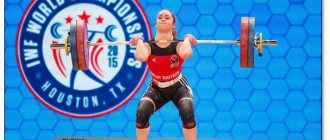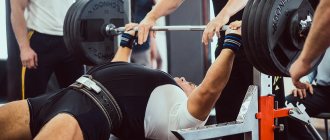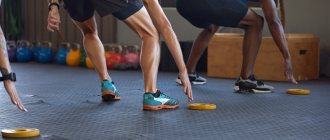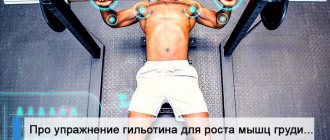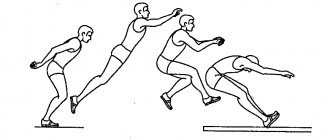Kettlebell lifting is a sport that is based on exercises with weights and their repetition as many times as possible. In this article we will look at the types of exercises, as well as the various standards of kettlebell lifting.
It is worth noting here that to perform exercises both in normal and competitive form, weights of 16 kilograms, 24 kilograms and 32 kilograms are used.
To ensure fair execution, the weight of the athlete performing the exercises is also taken into account:
- There are eight male weight categories: up to 63 kilograms, up to 68 kilograms, up to 73 kilograms, up to 78 kilograms, up to 85 kilograms, up to 95 kilograms, up to 105 and over 105 kilograms.
- Women currently have five categories: up to 53 kilograms, up to 58 kilograms, up to 63 kilograms, up to 68 kilograms, over 68 kilograms.
Conditions for performing exercises
Having dealt with the exercises themselves, we can move on to the conditions and standards of kettlebell lifting. So, for all three types of exercises there are certain rules that must be followed, namely:
- The athlete is given ten minutes to complete this task.
- In each exercise it is necessary to fix the weight.
- You must always keep your balance.
It is worth taking into account that:
- The double event consists of a clean and jerk and a snatch, and points for them are awarded separately: 1 clean and jerk = 1 point, 1 snatch = 0.5 points.
- Mass categories are assigned at any competition.
- The rank of Candidate Master of Sports (CMS) is awarded at competitions of a higher status.
- The rank of Master of Sports (MS) is awarded in the semi-finals of the Russian Championship.
Standards for master of sports in kettlebell lifting
The table also contains data for candidates for master of sports (CMS) and international masters of sports (MSMS).
Classic men's biathlon:
| Athlete weight | Kettlebell weight - 32 kilograms | ||
| Master of Sport | MSMK | KMS | |
| 63 kilograms | 100 points | 170 points | 70 points |
| 68 kilograms | 115 points | 185 points | 78 points |
| 73 kilograms | 130 points | 195 points | 86 points |
| 78 kilograms | 140 points | 205 points | 97 points |
| 85 kilograms | 150 points | 215 points | 111 points |
| 95 kilograms | 155 points | 223 points | 120 points |
| 105 kilograms | 160 points | 220 points | 115 points |
| +105 kilogram | 165 points | 222 points | 120 points |
Long cycle push of two weights. Number of lifts.
Men:
| Athlete weight | Kettlebell weight - 32 kilograms | ||
| MS | MSMK | KMS | |
| 63 kilograms | 47 climbs | 48 climbs | 28 climbs |
| 68 kilograms | 44 climbs | 57 climbs | 35 climbs |
| 73 kilograms | 49 climbs | 64 lifts | 41 lifts |
| 78 kilograms | 53 climbs | 69 climbs | 45 climbs |
| 85 kilograms | 57 climbs | 75 climbs | 48 climbs |
| 95 kilograms | 60 lifts | 80 lifts | 52 climbs |
| 105 kilograms | 62 lifts | 82 lifts | 55 climbs |
| +105 kilogram | 64 lifts | 85 climbs | 57 climbs |
Jerk. Number of lifts.
Women:
| Athlete weight | Kettlebell weight - 24 kilograms | ||
| MSMK | MS | KMS | |
| 58 kilograms | 120 lifts | 100 lifts | 55 climbs |
| 63 kilograms | 130 climbs | 110 lifts | 63 lifts |
| 68 kilograms | 140 climbs | 120 lifts | 69 climbs |
| 68+ kilograms | 150 climbs | 130 climbs | 73 lifts |
FEATURES OF DIFFERENTIATION OF WEIGHT CATEGORIES OF ATHLETES DOING Kettlebell lifting
L.L. Tsipin, Candidate of Pedagogical Sciences, Professor of the Department of Biomechanics,
I.E. Barnikova, Candidate of Pedagogical Sciences, Associate Professor of the Department of Biomechanics,
A.V. Samsonova, Doctor of Pedagogical Sciences, Professor, Head of the Department of Biomechanics,
G.P. Vinogradov, Doctor of Pedagogical Sciences, Professor, Head of the Department of Theory and Methods of Athleticism.
National State University of Physical Culture, Sports and Health named after P.F. Lesgafta, St. Petersburg.
Contact information for correspondence: 190121, Russia, St. Petersburg, st. Dekabristov, 35, e-mail
Currently, kettlebell lifting has gained recognition in many countries around the world. Improving the methods of training athletes is one of the reasons why the rules of competitions in kettlebell lifting, including weight categories, have been changed several times. Experts have different opinions on the issue of the number and boundaries of weight categories. There are practically no works with scientific substantiation of the optimal number and boundaries of weight categories. In this regard, a study was conducted, the purpose of which was to substantiate a possible version of weight categories in kettlebell lifting based on a statistical analysis of the results of men’s performances at major all-Russian competitions. The results in the classic double event and the long cycle 32 kg kettlebell clean and jerk, shown from 2010 to 2020 at 46 competitions, were taken as the initial data for the analysis. A total of 6349 results were processed. The analysis showed that in biathlon the results in adjacent weight categories of 85 and 95 kg, 95 and 95+ kg do not differ significantly. In the long cycle clean and jerk, the results in the weight categories 73 and 78 kg, 85 and 95 kg, 95 and 95+ kg also do not differ significantly. The difference in results when moving from light to heavy weight categories decreases. The strength of the relationship between the results and weight of athletes in adjacent weight categories is weak. There is a definite tendency for results to increase with increasing weight of athletes throughout the entire range of their changes. Based on the data obtained, a possible version of weight categories for weightlifting athletes was proposed: up to 63, 68, 78 and over 78 kg. The proposed option differs in that the results of competitive exercises in all adjacent weight categories are significantly different and their difference is approximately the same. The boundaries of the weight categories are close to the existing ones.
Key words: kettlebell lifting, biathlon, long cycle clean and jerk, weight categories, statistical analysis.
Introduction. Kettlebell lifting has a long history in Russia and has gone through several stages in its development. It began to emerge as a separate sport in the late 40s of the last century. The first rules for kettlebell lifting competitions were developed in 1962, and in 1985 it was included in the Unified All-Union Sports Classification [2, p. 7]. Currently, kettlebell lifting has gained recognition both in our country and in many other countries of the world. The International Kettlebell Lifting Union (IUKU) includes 50 countries representing almost all continents.
With the development of kettlebell lifting, the rules of competitions were repeatedly changed. These changes concerned weight categories, composition of exercises, weight of equipment, time for performing exercises, and features of judging. The change in competition rules is associated with the improvement of athletes’ training methods, which at the initial stages was mainly reduced to the development of strength abilities themselves and, to a lesser extent, affected the development of strength endurance [3, p. 9-12]. The entertainment value of the competitions also increased. Until 1988, competitions were held in five weight categories: up to 60, 70, 80, 90 and over 90 kg. In 1989, the number of weight categories increased to six - a weight category of up to 65 kg was added. Since 1996, kettlebell lifting competitions began to be held in seven weight categories: up to 60, 65, 70, 75, 80, 90 and over 90 kg [5, p. 7]. Currently, the competition rules for men establish the following weight categories: up to 63, 68, 73, 78, 85, 95 and over 95 kg (weight 32 kg); for women - up to 58, 63, 68 and over 68 kg (weight 24 kg).
Entering a new stage of development, improving the techniques and methods of training kettlebell lifters has revealed a number of problematic issues, one of which is the number and boundaries of weight categories in kettlebell lifting. Experts have different opinions on this issue. This was reflected in the proposal of the President of the All-Russian Kettlebell Lifting Federation, Chairman of the Executive Committee of the International Kettlebell Lifting Union I.P. Solodov, who joined the leadership of NSU. P.F. Lesgafta, St. Petersburg in January 2020, to conduct research and give recommendations on the formation of optimal weight categories for weightlifting athletes. In the technical justification of the proposal by V.S. Rasskazov, who for a long time headed the All-Russian and then the International Kettlebell Lifting Federation, notes that due to the improvement of the technical preparedness of athletes and the increase in their strength endurance, weight categories in kettlebell lifting now do not play the same key role as 30-40 years ago. The ratio of technical results of athletes in light and heavy weight categories is decreasing. Moreover, results in medium weight categories are often higher than in heavy categories.
An analysis of domestic and foreign specialized literature has shown that there is only one work carried out by M. V. Starodubtsev in 1984, in which, along with consideration of other issues, the optimal number and boundaries of weight categories in kettlebell lifting are scientifically substantiated [4, p. 74-75]. To solve the problem, the author derived logarithmic equations expressing the dependence of the results in the clean and jerk of two 32 kg weights and the snatch of 32 kg weights on the athletes’ own weight. The results of the all-Union competitions held in April 1983 in Klaipeda were taken as the initial data. Taking as a basis the variant of weight categories existing in weightlifting, M.V. Starodubtsev showed that a number of weight categories: up to 60, 70, 80, 90, 110 and over 110 kg are quite acceptable from a scientific point of view. However, more than 30 years have passed since this study and the results of athletes have changed significantly. In addition to the classic double event, which includes a push of two kettlebells from the chest and a snatch of a kettlebell with one hand, athletes compete in the long cycle kettlebell jerk. In addition, in the above work the sample size was small and, in particular, for the push of two weights there were only 95 results.
The purpose of this study was to substantiate a possible option for weight categories in kettlebell lifting based on a statistical analysis of the results of men’s performances at major all-Russian competitions.
You can read about methods of statistical analysis of experiments in the book “Computer processing of experimental data”
Methodology. The initial data for the analysis are the results of weightlifting athletes in the classic combined event and the long cycle 32 kg kettlebell clean and jerk, shown from 2010 to 2020 at the following competitions: Russian Championships, Russian Cups, Kaluga Region Governor's Cups, Federal District Championships, Russian Championships among juniors, Championships of the European zone of Russia, Championships of the Asian zone of Russia, Championships of the Armed Forces of the Russian Federation. A total of 6349 results were processed based on the protocols of 46 competitions [6]. The weight categories did not change during the period under review.
Statistical processing of experimental data was carried out using the Statgraphics Centurion XVI package in several stages. At the first stage, a database of competition results by weight category was formed. At the second stage, the numerical characteristics of the samples were calculated, the compliance of the data distribution with the normal law was determined, and statistical hypotheses about the reliability of the differences between the results were tested. Testing was carried out using Student's t-test for independent samples. At the third stage, a correlation analysis was carried out, and the relationship was established between the results and the weight of athletes in weight categories. At the fourth stage, regression analysis was carried out to search for an adequate model of the relationship between the results and weight of athletes. At the fifth stage, the option of new weight categories was considered, and statistical hypotheses were tested about the reliability of the differences between the results in them.
Results and its discussion. Tables 1 and 2 present the average weight values of athletes and results in the combined event and long cycle clean and jerk in each of the currently accepted weight categories, as well as the reliability of differences between the results in adjacent weight categories.
As can be seen from Table 1, in the double event, the differences between the results in the 85 and 95 kg, 95 and 95+ kg categories turned out to be unreliable (p > 0.05). Noteworthy is the decrease in the difference in results when moving from light to heavy weight categories. Thus, the difference between the average results in the 63 and 68 kg categories is 11.3 points, and in the 78 and 85 kg categories – 6.4 points. The number of results, as one would expect, is greatest in the middle weight categories (73 and 78 kg).
Table 1 Distribution of the results of kettlebell lifters by weight category in classical biathlon (n=3990)
| Weight category, kg | n | Weight, kg M±m | Result, number of points M±m | Significance of differences in results |
| 63 | 551 | 62,12±0,04 | 105,9±1,5 | |
| p ≤ 0.001 | ||||
| 68 | 595 | 67,26±0,03 | 117,2±1,5 | |
| p ≤ 0.001 | ||||
| 73 | 669 | 72,12±0,04 | 125,8±1,4 | |
| p ≤ 0.001 | ||||
| 78 | 703 | 76,89±0,04 | 135,5±1,4 | |
| p ≤ 0.01 | ||||
| 85 | 573 | 82,89±0,08 | 141,9±1,7 | |
| p>0.05 | ||||
| 95 | 502 | 90,81±0,13 | 145,8±1,9 | |
| p>0.05 | ||||
| 95+ | 397 | 102,7±0,4 | 147,4±2,2 |
Note: hereinafter n is the number of results in each weight category.
Table 2 Distribution of results of kettlebell lifters by weight category in the long cycle clean and jerk (n=2359)
| Weight category, kg | n | Weight, kg M±m | Result, number of lifts M±m | Significance of differences in results |
| 63 | 265 | 62,45±0,04 | 44,8±0,7 | |
| p ≤ 0.001 | ||||
| 68 | 340 | 67,22±0,05 | 48,7±0,6 | |
| p ≤ 0.001 | ||||
| 73 | 356 | 71,72±0,09 | 52,0±0,7 | |
| p>0.05 | ||||
| 78 | 385 | 76,76±0,06 | 52,9±0,7 | |
| p ≤ 0.05 | ||||
| 85 | 352 | 82,8±0,10 | 55,3±0,7 | |
| p>0.05 | ||||
| 95 | 346 | 90,20±0,15 | 55,4±0,8 | |
| p>0.05 | ||||
| 95+ | 315 | 103,5±0,4 | 54,8±0,9 |
From Table 2 it follows that in the long cycle clean and jerk, as well as in the double event, the differences between the results in the categories of 85 and 95 kg, 95 and 95+ kg are not significant. In addition, the differences between the results in the 73 and 78 kg categories are not significant (p > 0.05). Similarly, the difference in results decreases when moving from light to heavy weight categories. Between the average results in the 63 and 68 kg categories, it is 3.9 lifts, and in the 78 and 85 kg categories – 2.4 lifts.
The absence of statistically significant differences between the results in individual weight categories indicates that the weight of athletes within these categories does not give them an advantage when performing a competitive exercise.
The strength of the relationship between the results and weight of athletes in adjacent weight categories, the results in which differ significantly, as shown by the correlation analysis, turned out to be weak. The Pearson correlation coefficient, which characterizes this relationship in the indicated weight categories, ranges from 0.10 to 0.22 in the double event, and from 0.09 to 0.22 in the long cycle clean and jerk. Correlation coefficients decrease from light to heavy weight categories.
The absence of significant differences between the results in the combined event and the long cycle clean and jerk in some weight categories and their weak relationship with the weight of athletes in others indicate the need to adjust the boundaries of the weight categories. To find their optimal option, the nature of the relationship between the results and the weight of athletes over the entire range of their changes must be known. Figure 1 shows a scatter diagram of the results of kettlebell lifters in the combined event, which shows a certain tendency for the results to increase with increasing weight of the athletes. Using regression analysis, the most adequate model of the relationship between the result in the combined event R and the athletes’ weight P was found:
Indicators of the quality of the regression equation are the coefficient of determination and standard error of regression. For the resulting equation, the coefficient of determination is 11.9%, and the standard regression error is 1.68. Such a low value of the coefficient of determination means that the result in biathlon is only 11-12% explained by the weight of the athletes and 88-89% by other factors. This is not accidental, since unlike, for example, weightlifting, where the dependence of the actual strength abilities and results shown on the weight of the athletes is obvious, in kettlebell lifting, strength endurance, which determines the results in competitive exercises, does not directly depend on the weight of the athletes. In addition, the results are largely determined by such factors as the technique of performing exercises and the morphological characteristics of athletes [1, p. 14-18].
Figure 1 – Scatter diagram of the results of kettlebell lifters in combined events
However, the data presented in Tables 1 and 2 and Figure 1 indicate that there is a certain tendency: as the weight of weight lifters increases, their results increase, both in the classical double event and in the long cycle clean and jerk. However, the currently accepted boundaries of weight categories and their number do not fully reflect this relationship.
When developing a possible version of weight categories for kettlebell lifters, the following basic provisions were taken into account:
- The results in the double event and long cycle clean and jerk in all adjacent weight categories should be significantly different.
- The difference between the average results in all adjacent weight categories should be approximately the same.
- The boundaries of weight categories should, if possible, correspond to existing ones.
The implementation of these provisions made it possible to propose the following version of weight categories for weight lifters: up to 63, 68, 78 and over 78 kg. Comparing the proposed option with the current one, you can see that the light weight categories up to 63 and 68 kg remained unchanged, the categories 73 and 78 kg were combined into one - 78 kg, the categories 85, 95 and over 95 kg were also combined into one - over 78 kg . Thus, the number of weight categories was reduced from seven to four. Tables 3 and 4 present the average weight values of athletes and results in the combined event and long cycle clean and jerk in each of the proposed weight categories, as well as the reliability of differences between the results in adjacent categories. The calculations used the results shown at competitions in existing weight categories on the assumption that they would not change if new weight categories were introduced.
Table 3 Distribution of results of kettlebell lifters by weight category (proposed option) in classical biathlon (n=3990)
| Weight category, kg | n | Weight, kg M±m | Result, number of points M±m | Significance of differences in results |
| 63 | 551 | 62,12±0,04 | 105,9±1,5 | |
| p ≤ 0.001 | ||||
| 68 | 595 | 67,26±0,03 | 117,2±1,5 | |
| p ≤ 0.05 | ||||
| 78 | 1372 | 74,56±0,07 | 130,7±1,0 | |
| p ≤ 0.05 | ||||
| 78+ | 1472 | 90,93±0,24 | 144,7±1,1 |
Table 4 Distribution of results of kettlebell lifters by weight category (proposed option) in the long cycle clean and jerk (n=2359)
| Weight category, kg | n | Weight, kg M±m | Result, number of lifts M±m | Significance of differences in results |
| 63 | 265 | 62,45±0,04 | 44,8±0,7 | |
| p ≤ 0.001 | ||||
| 68 | 340 | 67,22±0,05 | 48,7±0,6 | |
| p ≤ 0.001 | ||||
| 78 | 741 | 74,34±0,11 | 52,4±0,5 | |
| p ≤ 0.001 | ||||
| 78+ | 1013 | 91,8±0,3 | 55,2±0,5 |
Data from tables 3 and 4 indicate that the results in both the double event and the long cycle clean and jerk in all adjacent weight categories are significantly different (p ≤ 0.001-0.05). The difference between the average results by category in the double event varies from 11.3 to 14.0 points, and in the long cycle clean and jerk – from 2.8 to 3.9 lifts. With a certain degree of approximation, we can talk about a uniform increase in results when moving from one weight category to another.
Conclusion. A statistical analysis carried out on the basis of a fairly large sample made it possible to identify the nature of the dependence of the results of weight lifters on their own weight and to propose the optimal option for weight categories for men: up to 63, 68, 78 and over 78 kg. Naturally, the proposed option does not take into account all scientific, methodological and organizational factors that influence the division of athletes into weight categories, but can serve as a guide for specialists in developing new classification requirements and improving competition rules.
The study was carried out in accordance with the state assignment of the Federal State Budgetary Educational Institution of Higher Education “NSU named after. P.F. Lesgafta, St. Petersburg" to carry out the research work "Increasing the effectiveness of the use of special strength exercises in the preparation of qualified athletes of cyclic sports and combat sports based on a biomechanical analysis of the stereotypy and composition of motor actions of a competitive exercise" (registration number RIOKTR AAAA-A16- 116051110019-0, registration date 11/05/2016).
LITERATURE:
- Gomonov, V.N. Individualization of technical and physical training of weightlifting athletes of various qualifications: abstract of thesis. dis. ...cand. ped. Sciences: 13.00.04. – Smolensk, 2000. – 26 p.
- Polyakov, V.A. Kettlebell lifting: method. allowance / V.A. Polyakov, V.I. Voropaev. – M.: Physical culture and sport, 1988. – 80 p.
- Rasskazov, V.S. Ways and prospects for the development of kettlebell lifting / V.S. Stories. – Lipetsk: International Kettlebell Lifting Federation, 2004. – 33 p.
- Starodubtsev, M.V. Methodological approaches to the development of unified competition rules and rank standards in kettlebell lifting // Weightlifting: Yearbook. – M., 1984. – P. 73-77.
- Tikhonov, V.F. Basics of kettlebell lifting / V.F. Tikhonov, A.V. Sukhovey, D.V. Leonov. – M.: Soviet Sport, 2009. – 132 p.
- Competition protocols / Website of the All-Russian Kettlebell Lifting Federation. [Electronic resource]. – Access mode: https://www.vfgs.ru/ protocols (access date 08/10/2016).
